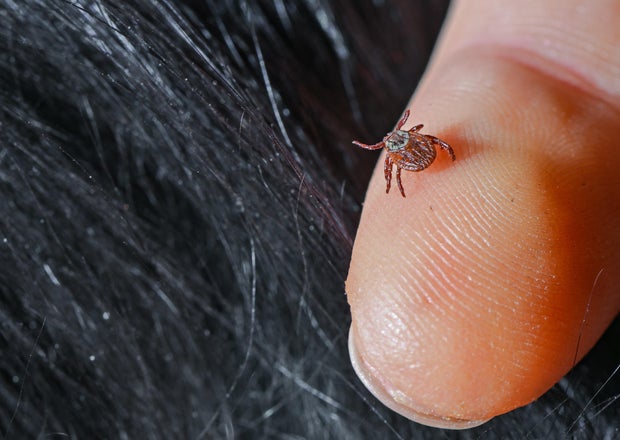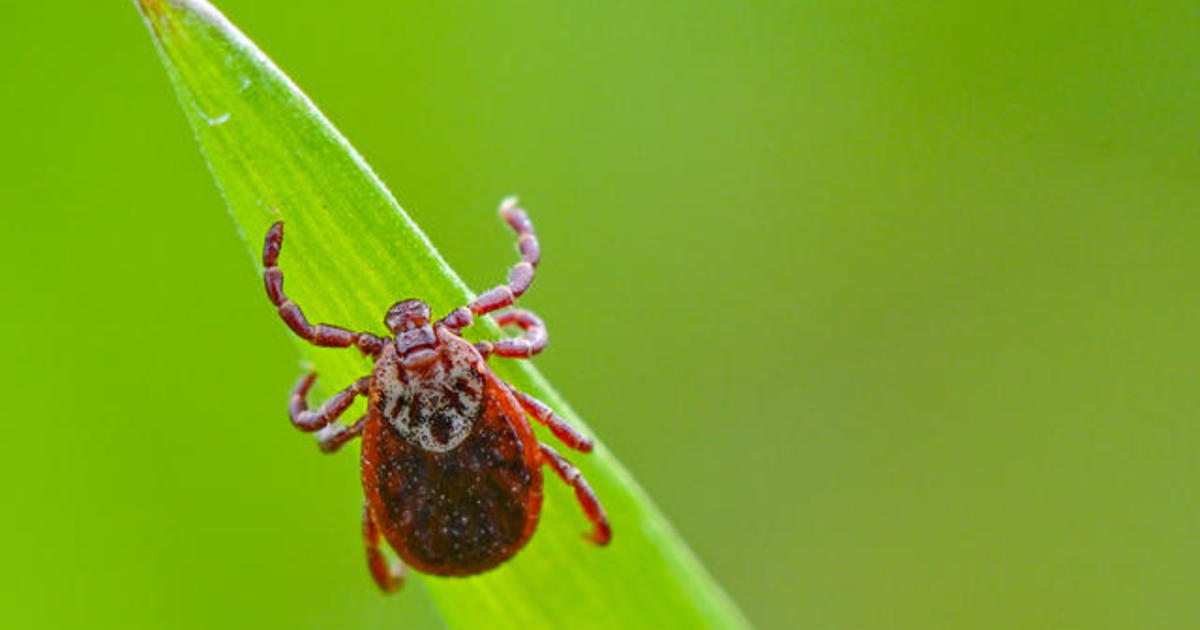CBS News
What do ticks look like? How to spot and get rid of them, according to experts

Tick bites can cause a range of different illnesses — and as the weather warms up, ticks can be particularly prevalent.
In some areas, ticks have emerged even earlier due to milder winters. Minnesota’s Metropolitan Mosquito Control District said they found their first deer tick of the year in February, for example, when typically they aren’t seen until March or April.
“One thing that’s of concern about this past winter is that we didn’t have a lot of those super cold days and those usually kill off some ticks,” Alex Carlson with the Metropolitan Mosquito Control District told CBS Minnesota.
Without more cold days, Carlson suspects spring may bring a more severe tick season.
“Tick-borne diseases are on the rise throughout the country and here in Minnesota. We’re seeing an increase in Lyme disease and other tick-borne diseases out there, so it’s very important that people are aware, tick aware,” he said.
Here’s what else to know:
What do ticks look like?
Ticks are typically small, flat and oval with no wings, according to Terminix, with colors ranging from grayish-white, brown, black, reddish-brown and yellowish.
“Nymphs and adults will have eight legs, but tick larvae only have six,” the pest control company’s website reads. “Ticks are capable of biting at all three of their active life stages: larval, nymph and adult.”
Patrick Pleul/picture alliance via Getty Images
Depending on their life stage, most ticks can range from the size of a grain of sand to a sesame seed to an apple seed or pencil eraser, Terminix describes.
After feeding from their host, however, ticks become engorged and larger in appearance.
“When fully-engorged, hard ticks typically increase in size to become close to twice the size of an unfed tick adult,” Orkin describes.
Ticks also consists of two parts: a head and abdomen.
“The tick’s head is very small compared to its abdomen, so much so that oftentimes they are described as looking like a body with six or eight curved legs,” Orkins’ website notes.
Still not sure if what you’re seeing is a tick?
The Centers for Disease Control and Prevention has a tick identification page with photos of commonly found species in the U.S. The page also includes a size chart for a few ticks that commonly bite humans: the blacklegged tick, lone star tick and American dog tick.
How to get rid of ticks
If you find a tick on you, you’ll want to remove it quickly and correctly.
“Don’t wait to have it removed,” Bryon Backenson, an assistant professor at the University of Albany School of Public Health, previously told CBS News. “With a fine-point pair of tweezers, get as close to the skin as you possibly can and gently and firmly pull straight up and that tick will pop right out.”
Sebastian Willnow/picture alliance via Getty Images
If you’re worried about bringing ticks inside on your clothes, putting your outdoor clothes in a hot dryer for about 10 minutes is “enough to kill a tick,” Backenson says.
You should also never crush a tick with your fingers. Instead, the CDC says to dispose of a live tick by putting it in alcohol,
putting it in a sealed bag, wrapping it tightly in tape or flushing it down the toilet.
After removing a tick from your skin, clean the bite area and your hands with rubbing alcohol or soap and water, the CDC recommends.
When should you worry about a tick bite?
After a tick removal or suspected tick bite, keep an eye on the area. If symptoms occur, experts advise seeing a doctor.
A tick bite may look like a “tiny, itchy bump on your skin” similar to a mosquito bite, according to the Mayo Clinic. But some people may not even notice they’ve had a tick bite.
Being bitten doesn’t necessarily mean you’ll get a tick-borne disease. However, if the tick was carrying borrelia bacteria (the bacteria that causes Lyme disease), early symptoms usually happen within 3 to 30 days after a bite.
A bull’s-eye-shaped rash is a common sign.
“It’s a rash that doesn’t always look just like a bull’s-eye, but it’s a red patch. It’s relatively large, usually at least 2 inches or so across,” Backenson explains. “Oftentimes it doesn’t hurt or itch, it’s just there.”
Ticks that can carry borrelia bacteria live throughout most of the United States, though Lyme disease is most common in the upper Midwest and the northeastern and mid-Atlantic states.
Certain tick bites can also cause alpha-gal syndrome, a potentially life-threatening allergic reaction to eating red meat. Evidence suggests the reaction is triggered by lone star ticks, which can be found in the southeastern and eastern United States, but “other kinds of ticks have not been ruled out,” the CDC says.
Powassan virus, a rare, difficult to diagnose tick-borne infection found mostly in the Northeast, can cause meningoencephalitis, or inflammation and infections of the brain.
“Patients who have had this viral encepahlitis can have significant neurological problems, if they recover,” Dr. Jeannina Smith, an infectious disease specialist at UW Health, previously told CBS News.
Powassan virus, like Lyme disease, presents with flu-like symptoms and can progress to confusion and difficulty speaking. Both infections require medical attention as soon as possible. Alpha-gal syndrome can cause skin and gastrointestinal issues among other symptoms.
-The Associated Press contributed to this report.
CBS News
The cream of the crop in butter

Watch CBS News
Be the first to know
Get browser notifications for breaking news, live events, and exclusive reporting.
CBS News
Baking an ancient bread in Tennessee

Watch CBS News
Be the first to know
Get browser notifications for breaking news, live events, and exclusive reporting.
CBS News
Good enough to eat: Noah Verrier’s paintings of comfort food

Watch CBS News
Be the first to know
Get browser notifications for breaking news, live events, and exclusive reporting.






